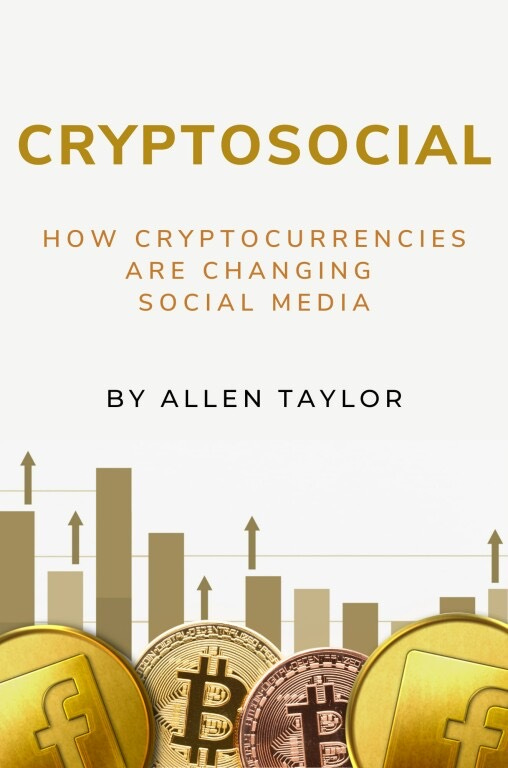Are You Cryptosocial?
Allen Taylor’s New Book Explores How The World of Cryptocurrencies Is Changing Social Media
Over the past decade or so, the cryptocurrency movement has been a major accelerant to the massive, multi-billion dollar growth and popularity of the social media industry. In light of this trend, the intersection between social media, cryptocurrency, and blockchain continues to evolve in new and innovative ways.
Many are now asking about how this collision came to be. Questions abound about how social media platforms will continue to impact the trajectory of cryptocurrency. And vice-versa as digital currency and blockchain have continued to mint creative and innovative projects in the social space.
These themes are the focus of an exciting new book entitled Cryptosocial: How Cryptocurrencies Are Changing Social Media, written by Allen Taylor. In it, Taylor, a writer and colleague of mine at Gokhshtein Media, surveys the historical landscape of social media and cryptocurrencies to chart the collision between these two technologies.
Taylor asserts that if you are among a growing number of people who have grown weary of legacy social media and how it often takes advantage of its own users then his book is a must-read.
As he notes: “To save the world from the evil empires of social media, a hero is rising up from the digital soil. Its superpower is a new technology called blockchain.”
It’s here where Cryptosocial deconstructs the ideas and ideologies that underlie hype and keep the crypto world trending. Taylor adroitly steers readers on a narrative highlighting “the strengths and weaknesses of the new platforms and protocols that are embedded in the features of the technology itself.”
Recently, I had the opportunity to interview Allen to discuss his new book and his panoptic look at this rapidly evolving space
Please tell us a little about your writing journey and what fueled your decision to publish “Cryptosocial.”
AT: I’ve been a writer since I’ve known what writing is. Sold my first piece in fifth grade. It was a puppet show script I had written for a group assignment. My group decided not to use it and a classmate wanted it, so I made $10. I was such an opportunist.
Years later, as an adult, I got tired of sales and corporate jobs and decided to get back to writing. I circulated a resume to newspapers around the Dallas-Fort Worth area and talked myself into an editor-in-chief position for a weekly community newspaper. In that capacity, I learned to write fast and won several industry awards.
So what was your entry point into the blockchain and crypto space?
AT: In 2006, I launched my freelance writing business and then began to specialize in fintech around 2013. A few years later, 2017, I was editor of an online publication focused on alternative lending. My boss wanted to start a new publication focused on blockchain technology and cryptocurrencies. Despite knowing nothing about these tech advancements at the time, he asked me if I wanted to edit that one too. “Sure,” I thought, “why not?” So I spent the next year editing Blockchain Times and learning everything I could about cryptocurrencies.
Describe your first major inflection point along the way.
AT: I learned about this new site called Steemit that allowed bloggers a way to earn cryptocurrencies by posting to the site. I joined it. In a year-and-a-half, as STEEM steadily declined in value, I managed to earn over $1,000 writing about what I felt like writing about. Then I started hearing about other platforms that had similar offers. In other words, post what you want, and earn crypto. After some research, I discovered more than 100 different projects. That’s when I decided to write a book about this new form of social media.
What sort of emerging trends are you seeing in terms of the intersection between social media and cryptocurrency?
AT: There are several.
First, new platforms are integrating NFTs in some way. For some, it’s NFT avatars for personal identity reasons. Others are integrating NFT marketplaces.
Another trend I see is DEX integration. In that regard, the platforms become more than just cryptosocial platforms. Loop, for instance, allows users a way to earn tokens for blogging, that they can then pool, farm, or stake to earn more. Torum is also moving in that direction.
A third trend is talk of cryptosocial entering the metaverse. I’m not sure what this means yet, but it will lead to users increasing their earning power.
Did you encounter any surprise discoveries while doing research for your book?
AT: Yes, of course. One thing I learned is that there is a huge diversity of crypto social media platforms in terms of what they have to offer. There are niche communities focused on common interests, there are social blogging platforms, social networking platforms, sites that focus on video sharing, and more.
Just as there is diversity in the way platforms are organized, there is also great diversity in tokenomics. Some sites have native cryptocurrencies while others are built on top of existing blockchains. Some don’t issue any tokens at all, like Publish0x, but allow you to earn tips or bounties. Then there are protocols that allow you to implement a system on your own website where you or your users can earn crypto.
Describe your greatest hope in terms of what readers walk away from your book with?
AT: I hope creators walk away with a vision for how they can turn their own talents into a means of earning crypto doing something they enjoy. If you’re a writer, there are a lot of writing opportunities that allow you to earn from your writing. If you’re a video creator, you have opportunities. Are you an artist? Interested in NFTs? Those opportunities are available.
There are also play-to-earn games that allow people to earn crypto just by playing. There’s a whole chapter on them in Cryptosocial.
Whatever talents you possess or interests you have, there is sure to be a cryptosocial platform—or two or three—that will cater to your interests. I hope creators and curators discover these and begin to use them for their own career and personal enhancement.





